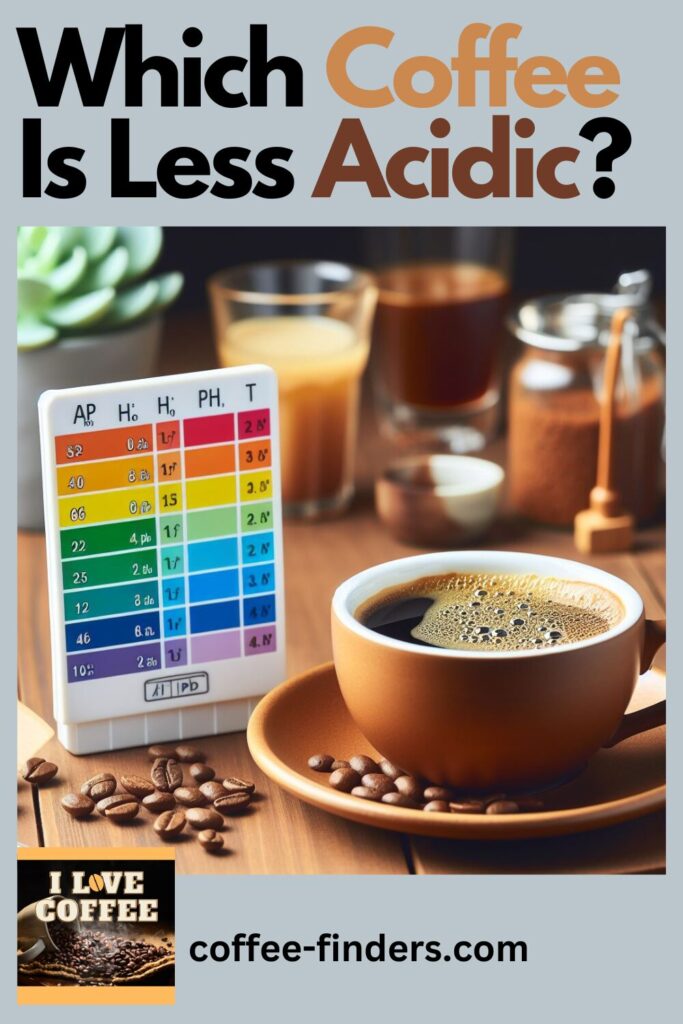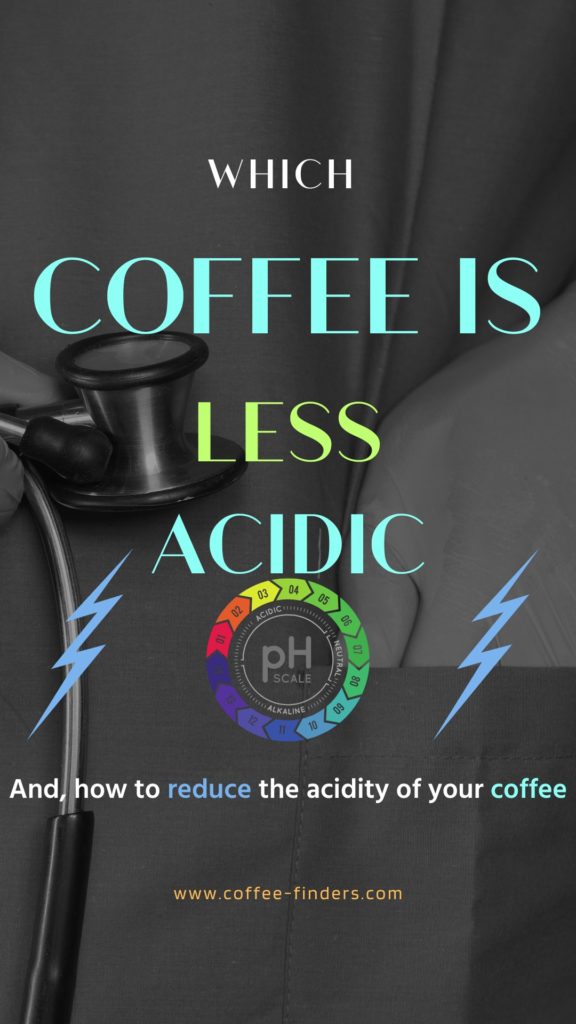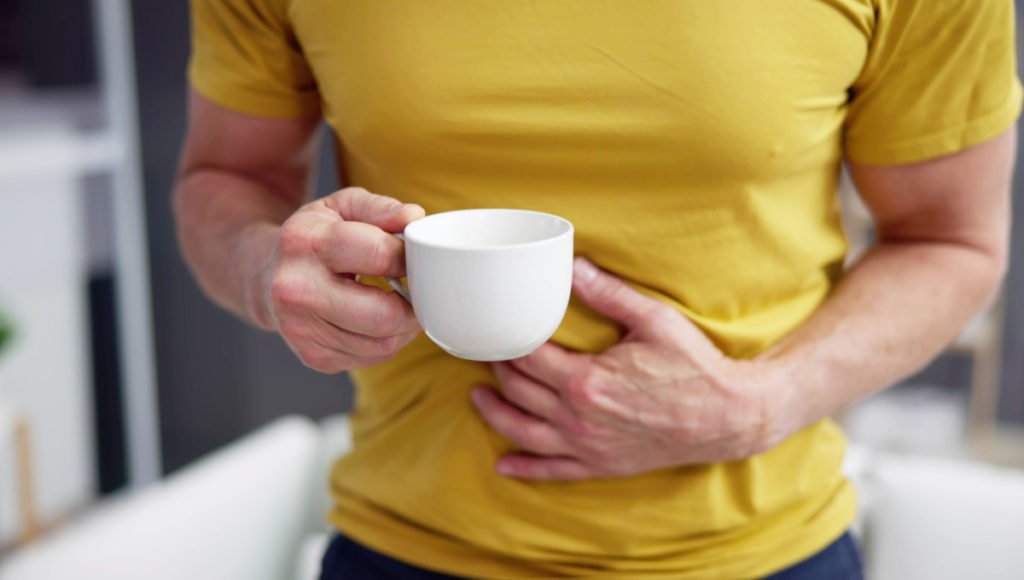If you love coffee but suffer from heartburn, acid reflux, or other digestive issues, you might wonder if there is a way to enjoy your favorite beverage without the unpleasant side effects. Coffee is naturally acidic, but some types of coffee are more acidic than others.
The acidity of coffee can affect its taste, aroma, and health benefits. In this post, we will explore why coffee is acidic, how it affects your body and health, and how you can reduce the acidity of your coffee. In the end, I will give you the answer to which coffee is less acidic and list some good alternatives or find low-acid coffee alternatives.
Disclaimer: Bear in mind, I am not a doctor or scientist. I have just been doing some research on the topic based on what is available information and tried to make it worthwhile for my readers. And some of the links might be affiliate links, meaning I might earn a small commission if you buy the products. This does however not make it any more expensive for you.
In this blog post we will look at the following:
Why Is Coffee Acidic?
Not only one doctor has told me to drink less coffee. Hard, I know. But, why? And, should I put coffee on hold?
Coffee is acidic because it contains various organic acids that are produced during the roasting and brewing processes. Some of the most common acids in coffee are:
- Chlorogenic acid: This is the main acid in green coffee beans. It has antioxidant and anti-inflammatory properties, but it also breaks down into quinic acid and caffeic acid during roasting.
Quinic acid is responsible for the sour and bitter taste of over-extracted or stale coffee, while caffeic acid contributes to the floral and fruity notes of coffee. - Citric acid: This is found in Arabica beans, especially those grown at high altitudes. It gives coffee a bright and citrusy flavor, but it can also cause stomach irritation in some people.
- Malic acid: This is also found in Arabica beans, especially those from Ethiopia and Kenya. It gives coffee a tart and apple-like flavor, but it can also trigger acid reflux in some people.
- Acetic acid: This is formed during the fermentation process of natural and honey-processed coffees. It gives coffee a vinegar-like aroma and flavor, but it can also lower the pH of your stomach and cause heartburn.
Feel free to pin the image to find the coffee brands easier later

- Lactic acid: This is also formed during the fermentation process of natural and honey-processed coffees. It gives coffee a creamy and milky flavor, but it can also increase the acidity of your stomach and cause indigestion.
The acidity of coffee is measured by its pH level, which ranges from 0 (very acidic) to 14 (very alkaline). The pH of coffee depends on many factors, such as the type of beans, the roast level, the brewing method, and the water quality.
Generally speaking, the pH of coffee ranges from 4.5 to 6, which makes it slightly acidic.
How Does Coffee Acidity Affect Your Body and Health?
The acidity of coffee can have both positive and negative effects on your body and health. On one hand, some of the acids in coffee have antioxidant and anti-inflammatory properties that can protect your cells from damage and reduce the risk of chronic diseases such as diabetes, cancer, and Alzheimer’s disease.
On the other hand, some of the acids in coffee can irritate your stomach lining, increase your stomach acid production, relax your lower esophageal sphincter (the valve that prevents stomach acid from flowing back into your esophagus), and cause symptoms such as heartburn, acid reflux, gastritis, ulcers, and GERD.

The effects of coffee acidity on your body and health depend on several factors, such as:
- Your individual sensitivity: Some people are more prone to experience digestive issues from coffee than others due to genetic factors or underlying medical conditions.
- Your coffee consumption: The more coffee you drink, the more likely you are to experience negative effects from its acidity.
- Your food intake: Drinking coffee on an empty stomach can worsen its acidity effects, while eating something before or with your coffee can buffer its acidity and reduce its impact on your stomach.
- Your lifestyle habits: Smoking, drinking alcohol, eating spicy or fatty foods, being overweight or obese, lying down after eating or drinking coffee, wearing tight clothing around your abdomen, or being stressed can all aggravate your digestive issues from coffee.
If you have the question: which coffee is less acidic, it may be you or your friends/families have some issues with this. If you want to enjoy your coffee without suffering from its acidity effects, there are some ways to reduce the acidity of your coffee or make it more tolerable for your stomach.
Feel free to pin the image to find the coffee brands later again
Next up, I will share some tips on how to reduce the acidity of your coffee:
How to Reduce the Acidity of Your Coffee
- Choose low-acid beans: Some types of beans are naturally lower in acid than others. For example, Robusta beans are lower in acid than Arabica beans; beans grown at lower altitudes are lower in acid than those grown at higher altitudes; beans from Brazil, Sumatra, India, Peru, and Mexico are lower in acid than those from Ethiopia, Kenya, Colombia, and Costa Rica. You can also look for low-acid or pH-balanced coffees that are specially processed to reduce their acidity.
- Choose a darker roast: The longer and hotter the beans are roasted, the more the chlorogenic acid breaks down into less acidic compounds. Darker roasts tend to be less acidic than lighter roasts, but they also have less of the original flavor and aroma of the beans. Sadly for me, I prefer medium roast…
- Choose a coarser grind: The finer the grind, the more surface area is exposed to water, which leads to more acid extraction. A coarser grind will result in a less acidic brew, but it will also require a longer brewing time and more water to achieve the same strength.
- Choose a different brewing method: Some brewing methods extract more acid from the coffee than others. For example, cold brew, French press, and percolator methods tend to produce less acidic coffee than drip, pour-over, and espresso methods. You can also adjust the brewing time, temperature, and ratio of coffee to water to reduce the acidity of your coffee.
- Add milk or cream: Milk or cream can neutralize some of the acids in coffee and make it smoother and creamier. However, some people may be lactose intolerant or allergic to dairy products, which can cause digestive issues of their own. You can also try non-dairy alternatives such as soy milk, almond milk, oat milk, or coconut milk.
- Add a pinch of salt: Salt can counteract some of the bitterness and sourness of coffee and enhance its sweetness. However, too much salt can make your coffee taste salty and increase your sodium intake, which can have negative effects on your blood pressure and heart health
- Add a dash of baking soda: Baking soda is a natural alkaline substance that can raise the pH of your coffee and make it less acidic. However, too much baking soda can make your coffee taste chalky and affect its flavor.
- Add some spices: Spices such as cinnamon, cardamom, ginger, nutmeg, or cloves can add some flavor and aroma to your coffee and mask some of its acidity. They may also have some health benefits such as anti-inflammatory, antioxidant, and antibacterial properties. Se my post on different flavors for coffee here.
Here are 11 of the Best Coffees with Less Acidic

- Lifeboost Coffee: This is our top pick for the best low-acid coffee brand. It uses naturally low-acid Arabica beans that are organic, fair trade, pesticide-free, and shade-grown. It has a rich flavor and a great aroma, and it is gentle on your stomach. You can choose from light, medium, or dark roast, and get whole beans or ground coffee.
- Volcanica Coffee: This is another excellent low-acid coffee brand that offers a variety of blends and single-origin coffees from different regions. They use high-quality Arabica beans that are grown at high altitudes and volcanic soils, which reduce the acidity and enhance the flavor. They also roast their beans in small batches to ensure freshness and consistency.
- Mommee Coffee: This is a low-acid coffee brand that is specially designed for moms-to-be, moms who breastfeed, and moms who want to balance their hormones. It uses organic, fair trade, water-processed beans that are low in acid and caffeine, but high in flavor and antioxidants. It also supports women’s health and empowerment by donating a portion of their profits to charities that help mothers and children. You can choose from decaf, quarter caf, half caf, or full caf, and get whole beans or ground coffee.
- Bulletproof Coffee: This is a low-acid coffee brand that is famous for its bulletproof coffee recipe, which involves blending coffee with grass-fed butter and MCT oil. This creates a creamy and satisfying drink that boosts your energy, metabolism, and brain function. The coffee beans are organic, rainforest alliance certified, and tested for toxins and mold. They also have a smooth and full-bodied flavor that is easy on your stomach. You can choose from medium or dark roast, and get whole beans or ground coffee by clicking [here].
- Manatee Coffee: This is a low-acid coffee brand that is also environmentally friendly and socially responsible. It uses Arabica beans that are grown in Central and South America under shade trees that provide habitat for manatees and other wildlife. It also supports the Save the Manatee Club by donating a percentage of their sales to protect these endangered animals. The coffee has a mild and smooth flavor that is suitable for sensitive stomachs. You can choose from medium or dark roast, and get pre-ground coffee by clicking [here].
- Clean Coffee Co.: This is a low-acid coffee brand that is also organic, non-GMO, gluten-free, vegan, and keto-friendly. It uses Arabica beans that are grown in Colombia without pesticides or chemicals. It also uses a natural roasting process that reduces the acidity and bitterness of the coffee while preserving its flavor and aroma. The coffee has a medium-dark roast that is rich and balanced. You can get whole beans or ground coffee by clicking [here].
- Puroast Coffee: This is a low-acid coffee brand that claims to have 70% less acid than other leading brands. It uses a proprietary roasting technique that mimics the traditional way of making coffee in Venezuela. This results in a smooth and delicious coffee that is also high in antioxidants and natural oils. The coffee has no bitter aftertaste and is gentle on your stomach. You can choose from different flavors and roasts, and get whole beans or ground coffee by clicking here.
- Java Planet Coffee: This is a low-acid coffee brand that is also organic, fair trade, non-GMO, bird-friendly, and family-owned. It uses Arabica beans that are grown in various regions around the world under sustainable practices. It also roasts its beans in small batches to ensure quality and freshness. The coffee has a medium-dark roast that is smooth and flavorful with hints of chocolate and caramel
- HealthWise Coffee: This is a low-acid coffee brand that uses a patented roasting process that preserves the natural pH of the coffee beans. It uses 100% Colombian Arabica beans that are organic and kosher-certified. It has a smooth and full-bodied flavor that is easy on your stomach and teeth. You can choose from different roasts and flavors, and get whole beans or ground coffee by clicking [here].
- Tieman’s Fusion Coffee: This is a low-acid coffee brand that blends coffee with natural antioxidants from tea and goji berries. It uses Arabica beans that are grown in Central and South America under organic and fair trade standards. It has a smooth and rich flavor that is also good for your health. You can choose from different blends and roasts, and get whole beans or ground coffee by clicking [here].
- Trücup Coffee: This is a low-acid coffee brand that uses a natural water and steam process to remove most of the acids from the coffee beans. It uses Arabica beans that are sourced from various regions around the world. It has a smooth and satisfying flavor that is gentle on your stomach and esophagus. You can choose from different roasts and flavors, and get whole beans or ground coffee by clicking here.



These are some of the best low-acid coffee brands that you can try if you want to enjoy your coffee without the burn. You can find them online or in some local stores or cafes. You can also compare their prices, reviews, and ratings to find the best one for you.
I hope this list has helped you find some low-acid coffee brands that suit your taste buds and your stomach. But I do not stop here. There are other alternatives.
And here are 11 Low-Acid Coffee Alternatives
If you want to avoid coffee altogether or switch to a different beverage once in a while, there are some low-acid alternatives that can still give you a boost of energy and flavor.
Here are some options:
- Chicory root coffee: This is made from roasted and ground chicory root, which has a similar taste and appearance to coffee but is caffeine-free and low in acid. It is also rich in inulin, a type of fiber that can support your gut health and digestion.
- Matcha tea: This is a type of green tea that is made from finely ground tea leaves that are whisked with hot water. It has a vibrant green color and a grassy flavor. It is high in antioxidants, especially catechins, that can protect your cells from damage and lower your risk of chronic diseases. It also contains caffeine, but less than coffee.
- Yerba mate: This is a traditional South American drink that is made from dried leaves and twigs of the yerba mate plant that are steeped in hot water. It has a bitter and earthy flavor. It is high in antioxidants, vitamins, minerals, and amino acids that can support your immune system and metabolism. It also contains caffeine, but less than coffee.
- Herbal tea: There are many types of herbal teas that are made from various herbs, flowers, fruits, and spices that have different flavors and health benefits. Some examples are chamomile tea, peppermint tea, ginger tea, turmeric tea, and lemon balm tea. They are caffeine-free and low in acid.
- Chai tea: This is a spiced black tea that is brewed with milk and sugar. It has a rich and creamy flavor with hints of cinnamon, cardamom, ginger, cloves, and other spices. It is high in antioxidants that can fight inflammation and oxidative stress. It contains caffeine, but less than coffee.
- Golden milk: This is a warm drink that is made from milk (dairy or non-dairy), turmeric, ginger, black pepper, and honey or maple syrup. It has a golden yellow color and a spicy and sweet flavor. It is high in antioxidants and anti-inflammatory compounds that can support your immune system and digestion. It is caffeine-free and low in acid.
- Kombucha: This is a fermented drink that is made from sweetened black or green tea that is mixed with bacteria and yeast cultures. It has a fizzy texture and a tangy flavor with hints of vinegar and fruit. It is high in probiotics that can improve your gut health and digestion and antioxidants that can protect your cells from damage and lower your risk of chronic diseases . It is low in acid, but it may contain some caffeine depending on the type of tea used.
- Rooibos tea: This is a herbal tea that is made from the leaves of the rooibos plant that are native to South Africa. It has a reddish-brown color and a nutty and sweet flavor. It is high in antioxidants, especially aspalathin, that can protect your cells from damage and lower your blood pressure and cholesterol levels . It is caffeine-free and low in acid.
- Barley coffee: This is a caffeine-free drink that is made from roasted and ground barley grains that are brewed like coffee. It has a dark color and a roasted and malty flavor. It is high in fiber, minerals, and antioxidants that can support your digestive health and lower your blood sugar levels . It is low in acid, but it may contain gluten, which can cause allergic reactions in some people.
- Dandelion root coffee: This is a caffeine-free drink that is made from roasted and ground dandelion roots that are brewed like coffee. It has a dark color and a bitter and earthy flavor. It is high in vitamins, minerals, and antioxidants that can support your liver health and detoxification . It is low in acid, but it may interact with some medications, such as blood thinners or diuretics.
- Mushroom coffee: This is a drink that is made from coffee mixed with powdered mushrooms, such as reishi, chaga, lion’s mane, or cordyceps. It has a similar color and flavor to coffee, but with some earthy and nutty notes. It is high in antioxidants, anti-inflammatory compounds, and adaptogens that can support your immune system, brain function, and stress response . It contains caffeine, but less than coffee.




These are some of the low-acid coffee alternatives that you can try if you want to enjoy a hot or cold drink without the burn. You can find them online or in health food stores or specialty shops. You can also experiment with different flavors and sweeteners to suit your taste buds.
Conclusion – Which Coffee Is Less Acidic
Coffee is acidic because it contains various organic acids that are produced during the roasting and brewing processes. The acidity of coffee can affect its taste, aroma, and health benefits. Some people may experience digestive issues from coffee due to its acidity, such as heartburn, acid reflux, gastritis, ulcers, or GERD. So that is why some wonder: which coffee is less acidic?
There are some ways to reduce the acidity of your coffee or make it more tolerable for your stomach, such as choosing low-acid beans, a darker roast, a coarser grind, a different brewing method, or adding milk, cream, salt, baking soda, or spices to your coffee.
You can also switch to low-acid alternatives that can still give you a boost of energy and flavor, such as chicory root coffee, matcha tea, yerba mate, herbal tea, chai tea, golden milk, kombucha, rooibos tea, barley coffee, dandelion root coffee, or mushroom coffee.
I hope this post on Which Coffee Is Less Acidic, has helped you learn more about which coffee is less acidic and how to enjoy your cup without the burn. If you have any questions or comments, please feel free to leave them below. Thank you for reading!

